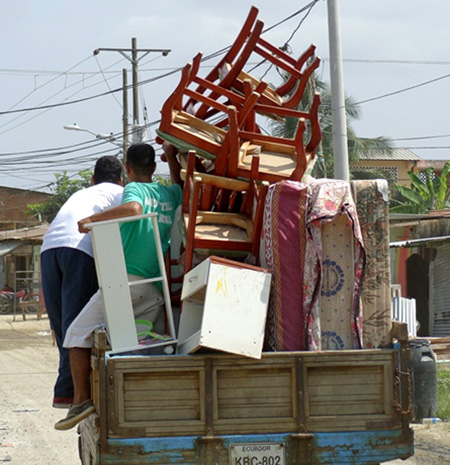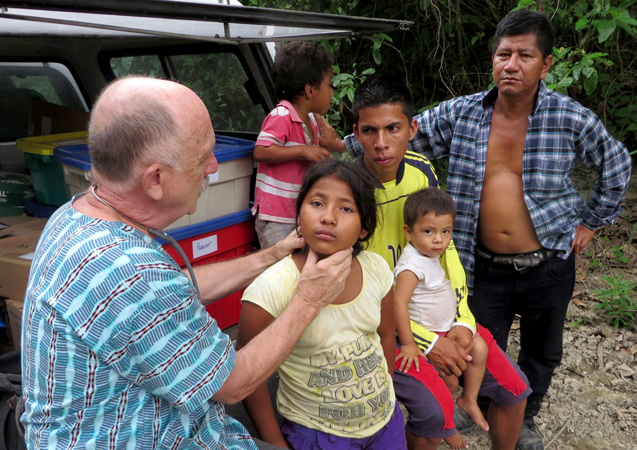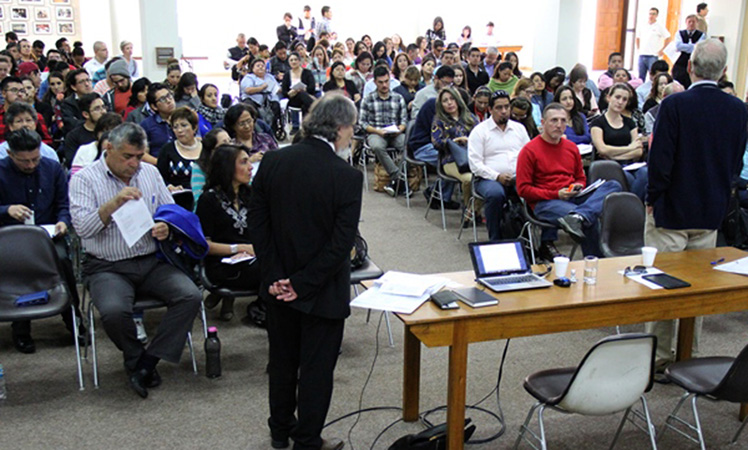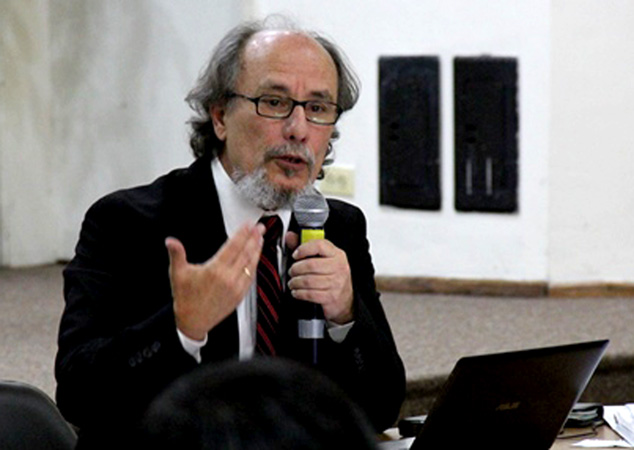MENU
(May 31, 2016 - by Ralph Kurtenbach) When home is no longer a refuge but has become instead a threat, what are your options?
This is no theoretical question for thousands of Ecuadorians. Displaced by a 7.8-magnitude earthquake, their homes are different than before. Their new normal means bedding down in tents after the April 16 temblor shook down homes and hotels alike in two of Ecuador’s coastal provinces, Esmeraldas and Manabí.
 A displaced Ecuadorian's daily rhythms may include cooking outdoors along with doing pretty well everything else in a camp setting—waking up and brushing teeth, caring for kids, visiting, eating. Or it may mean sharing a common kitchen with people who were not neighbors prior to the earthquake.
A displaced Ecuadorian's daily rhythms may include cooking outdoors along with doing pretty well everything else in a camp setting—waking up and brushing teeth, caring for kids, visiting, eating. Or it may mean sharing a common kitchen with people who were not neighbors prior to the earthquake.
Statistics vary, but the Secretaría Nacional de Riesgos (National Secretariat for Risks or SNGR) says that 22,754 people are in such camps. The Ministerio de Inclusión Económica y Social (Economic and Social Inclusion Ministry or MIES) put that number at more than 28,439. Earlier this month, MIES announced that its technicians would survey the camps to establish why people are staying and what it would take to return them to their home communities.
“Life in the shelters was uncomfortable,” Rosa Arias told the Quito newspaper El Comercio about a month after the devastating quake. “So my family and I decided to go to the island (Muisne) to begin again.” She fled Muisne in Esmeraldas province along with some 1,500 others who moved to shelters at Pueblo Nuevo and El Salto for those displaced by the mid-April quake.
In an adjacent province, Ana Vinces and her four children live in a tent donated by the United Nations High Commissioner for Refugees (UNHCR). Fear of returning home keeps them there, along with a desire for government assistance on rebuilding or repairs. Their house—where Vinces’ mother occupies the first floor—has an upper-level bathroom with cracked walls. “I have been trying to get my own place,” Vinces said. “I could make payments of up to $150 [per month].”
Life is similar for Eduardo Chinga. His family refused to go back into the house to live even though damages were light. They prefer staying at the displaced persons camp to reduce emotional stress.”
 While close quarters in a temporary campsite may prove hard over the long haul, this reveals a mere glimpse of life for those recovering since an apocalyptic event in April changed their world.
While close quarters in a temporary campsite may prove hard over the long haul, this reveals a mere glimpse of life for those recovering since an apocalyptic event in April changed their world.
The deeper trauma and more shadowy thoughts reside within the hearts and minds of these displaced Ecuadorians. For some, the post-trauma emotions remain even after the departure of volunteers who may have come from an adjacent province or from half a world away.
One such volunteer is Reach Beyond missionary Hermann Schirmacher of Quito, Ecuador’s capital city. He observed that “the fear that people continue to have cannot be taken away with a candy bar, a medical visit or with a smile—even less with any kind of medicine,” but that hasn’t diminished his desire to help out. Since mid-April he has coordinated three (leading two of them) Reach Beyond emergency medical response teams following the humanitarian crisis in western Ecuador.
A family practice physician, Dr. Steve Nelson, attended to hundreds of patients in the affected area, finding that “an ongoing issue with people is the anxiety of a possible further earthquake.”
 For many in Esmeraldas province those fears were realized on Wednesday, May 18, when a pair of 6.8-magnitude aftershocks, several hours apart, shook the area. A person died and several dozen suffered light injuries. The fear of returning home is very real.
For many in Esmeraldas province those fears were realized on Wednesday, May 18, when a pair of 6.8-magnitude aftershocks, several hours apart, shook the area. A person died and several dozen suffered light injuries. The fear of returning home is very real.
Schirmacher’s medical team (April 22-29) was accompanied by pastors and volunteers intent on helping fellow Ecuadorians begin to process the trauma they experienced.
Even as that team was onsite in Esmeraldas province, Reach Beyond psychologist Dr. Carlos Pinto was holding seminars in Quito and Guayaquil to train additional volunteers with their sights set on the quake zone.
 In a conference room crowded with people, he handed out copies of ¿Cómo Recuperarnos de una Tragedia? Manual de Intervención en Crisis (How Can We Recover from Tragedy? Crisis Intervention Manual).
In a conference room crowded with people, he handed out copies of ¿Cómo Recuperarnos de una Tragedia? Manual de Intervención en Crisis (How Can We Recover from Tragedy? Crisis Intervention Manual).
Throughout the day, Pinto moderated as spokesmen for different groups in the room summarized how their people had processed questions or topics that he put before them.
Among the attendees were Marco and Marta Claudia Mosquera whose live, call-in counseling program airs five afternoons a week on Radio Station HCJB in Quito. The Mosqueras have since traveled twice, both times on the invitation of local pastors, to minister to people in the hard-hit coastal region of Ecuador.
Sources: Reach Beyond, El Comercio, El Telégrafo
This is no theoretical question for thousands of Ecuadorians. Displaced by a 7.8-magnitude earthquake, their homes are different than before. Their new normal means bedding down in tents after the April 16 temblor shook down homes and hotels alike in two of Ecuador’s coastal provinces, Esmeraldas and Manabí.
 A displaced Ecuadorian's daily rhythms may include cooking outdoors along with doing pretty well everything else in a camp setting—waking up and brushing teeth, caring for kids, visiting, eating. Or it may mean sharing a common kitchen with people who were not neighbors prior to the earthquake.
A displaced Ecuadorian's daily rhythms may include cooking outdoors along with doing pretty well everything else in a camp setting—waking up and brushing teeth, caring for kids, visiting, eating. Or it may mean sharing a common kitchen with people who were not neighbors prior to the earthquake.Statistics vary, but the Secretaría Nacional de Riesgos (National Secretariat for Risks or SNGR) says that 22,754 people are in such camps. The Ministerio de Inclusión Económica y Social (Economic and Social Inclusion Ministry or MIES) put that number at more than 28,439. Earlier this month, MIES announced that its technicians would survey the camps to establish why people are staying and what it would take to return them to their home communities.
“Life in the shelters was uncomfortable,” Rosa Arias told the Quito newspaper El Comercio about a month after the devastating quake. “So my family and I decided to go to the island (Muisne) to begin again.” She fled Muisne in Esmeraldas province along with some 1,500 others who moved to shelters at Pueblo Nuevo and El Salto for those displaced by the mid-April quake.
In an adjacent province, Ana Vinces and her four children live in a tent donated by the United Nations High Commissioner for Refugees (UNHCR). Fear of returning home keeps them there, along with a desire for government assistance on rebuilding or repairs. Their house—where Vinces’ mother occupies the first floor—has an upper-level bathroom with cracked walls. “I have been trying to get my own place,” Vinces said. “I could make payments of up to $150 [per month].”
Life is similar for Eduardo Chinga. His family refused to go back into the house to live even though damages were light. They prefer staying at the displaced persons camp to reduce emotional stress.”
 While close quarters in a temporary campsite may prove hard over the long haul, this reveals a mere glimpse of life for those recovering since an apocalyptic event in April changed their world.
While close quarters in a temporary campsite may prove hard over the long haul, this reveals a mere glimpse of life for those recovering since an apocalyptic event in April changed their world.The deeper trauma and more shadowy thoughts reside within the hearts and minds of these displaced Ecuadorians. For some, the post-trauma emotions remain even after the departure of volunteers who may have come from an adjacent province or from half a world away.
One such volunteer is Reach Beyond missionary Hermann Schirmacher of Quito, Ecuador’s capital city. He observed that “the fear that people continue to have cannot be taken away with a candy bar, a medical visit or with a smile—even less with any kind of medicine,” but that hasn’t diminished his desire to help out. Since mid-April he has coordinated three (leading two of them) Reach Beyond emergency medical response teams following the humanitarian crisis in western Ecuador.
A family practice physician, Dr. Steve Nelson, attended to hundreds of patients in the affected area, finding that “an ongoing issue with people is the anxiety of a possible further earthquake.”
 For many in Esmeraldas province those fears were realized on Wednesday, May 18, when a pair of 6.8-magnitude aftershocks, several hours apart, shook the area. A person died and several dozen suffered light injuries. The fear of returning home is very real.
For many in Esmeraldas province those fears were realized on Wednesday, May 18, when a pair of 6.8-magnitude aftershocks, several hours apart, shook the area. A person died and several dozen suffered light injuries. The fear of returning home is very real.Schirmacher’s medical team (April 22-29) was accompanied by pastors and volunteers intent on helping fellow Ecuadorians begin to process the trauma they experienced.
Even as that team was onsite in Esmeraldas province, Reach Beyond psychologist Dr. Carlos Pinto was holding seminars in Quito and Guayaquil to train additional volunteers with their sights set on the quake zone.
 In a conference room crowded with people, he handed out copies of ¿Cómo Recuperarnos de una Tragedia? Manual de Intervención en Crisis (How Can We Recover from Tragedy? Crisis Intervention Manual).
In a conference room crowded with people, he handed out copies of ¿Cómo Recuperarnos de una Tragedia? Manual de Intervención en Crisis (How Can We Recover from Tragedy? Crisis Intervention Manual).Throughout the day, Pinto moderated as spokesmen for different groups in the room summarized how their people had processed questions or topics that he put before them.
Among the attendees were Marco and Marta Claudia Mosquera whose live, call-in counseling program airs five afternoons a week on Radio Station HCJB in Quito. The Mosqueras have since traveled twice, both times on the invitation of local pastors, to minister to people in the hard-hit coastal region of Ecuador.
Sources: Reach Beyond, El Comercio, El Telégrafo
